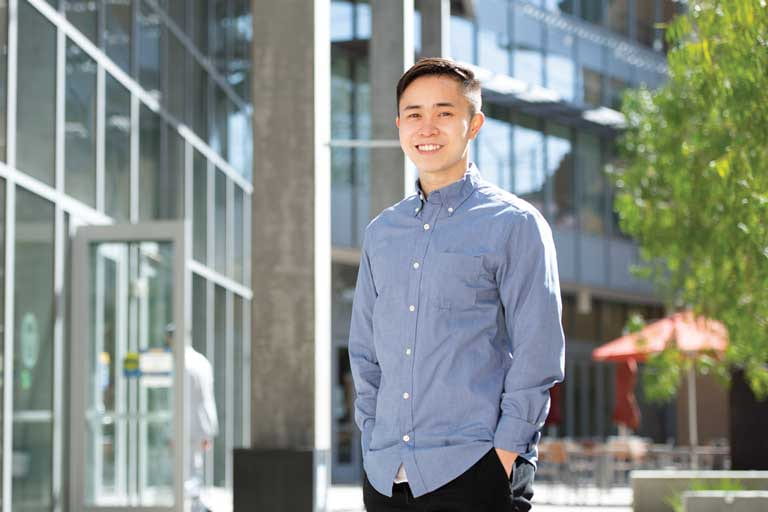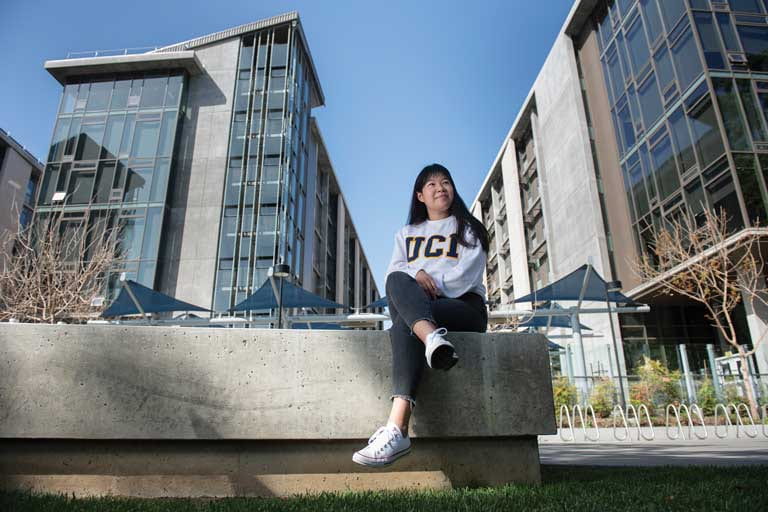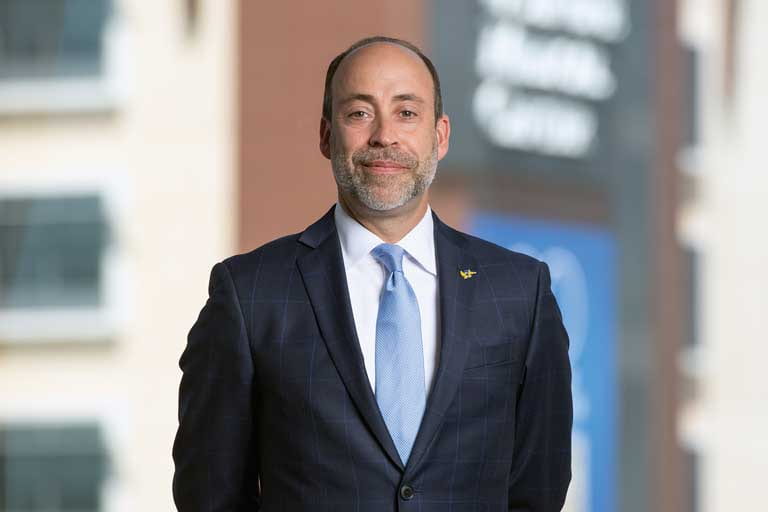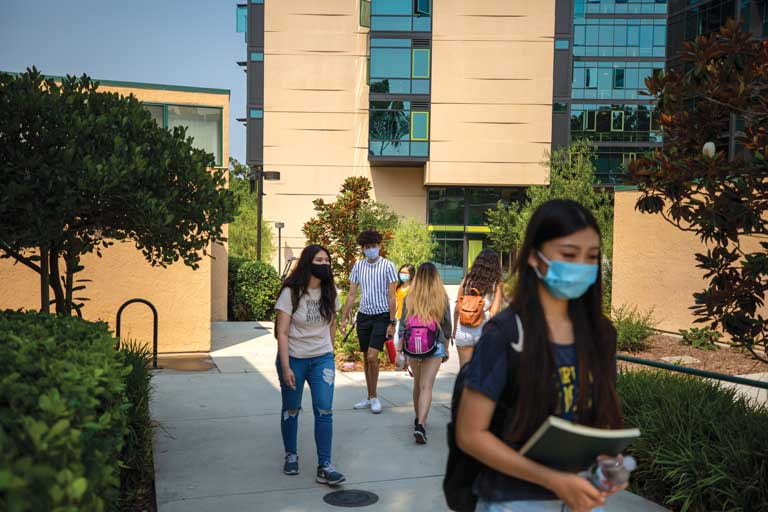The Anteater Experience
Resource-rich environment supports success of burgeoning student body
When Megan Kosai first arrived at UCI in fall 2019, she wasn’t sure what to expect and worried about feeling lost amid the campus’s 37,000 students.
“I honestly didn’t think I’d love UCI as much as I do,” Kosai says. “UCI is such a huge school, but it feels really personal and intimate, with the professors and the whole community taking the time to get to know each student individually.”
Now finishing her second year as a social ecology major, Kosai has joined a sorority, assists in a cognitive sciences research lab, is active with the Cross-Cultural Center and works in the Office of Undergraduate Admissions, speaking to prospective students about life at UCI.
While every student’s journey is unique, UCI provides a slew of programming and people focused on helping Anteaters like Kosai find their fit and thrive.
“Our work centers around students – making sure that at UCI they have the support needed to be the best leaders and citizens of the world,” says Willie Banks Jr., vice chancellor for student affairs. “We do that by marrying what students learn in the classroom with the experiences and opportunities they have outside the classroom.”
In the last decade, UCI enrollment has increased by 30 percent, and a growing number of students, Kosai included, come from low-income families. About 60 percent of UCI students are the first in their family to attend college. Based on the ethnic and economic demographics of the student body, UCI has been federally designated as both a Hispanic-Serving Institution and an Asian American and Native American Pacific Islander-Serving Institution.
UCI has topped The New York Times’ two most recent College Access Indexes of U.S. universities “doing the most for the American dream” and placed second in the U.S. News & World Report 2021 national listing of “Top Performers on Social Mobility,” which takes into account the graduation rate of students awarded Pell Grants.
“We’re accomplishing the American dream with the accessibility and social mobility we strive to provide for future generations,” says Rameen Talesh, dean of students and assistant vice chancellor for student life & leadership, who also earned an undergraduate degree at UCI. “So many of our students are here not just for themselves, but for their families. It means something of significance.”
Helping Students Thrive

Much of the programming established by Student Affairs in recent years focuses on easing students into a “soft landing” at UCI and then fostering their leadership skills.
“We want to make sure that students know the resources available to them and that they feel connected, whether it’s to a student leader or through residential life, student orientation or other student services,” Talesh says. “We know there are a lot of stressors too, so there’s an element of self-care in the student experience that’s much more prevalent now. We ask: How can we make sure our students are taking the time to slow down to enjoy and reflect on the experience – and meet them where they’re at?”
The Thrive@UCI seminar, a 1.3-unit course taught by administrators including Talesh, aims to continue connecting students to campus resources after their initial introduction through the Student Parent Orientation Program. Roughly 800 students have participated in Thrive@UCI since it debuted in 2015. Each week, the course covers a different campus resource, such as study abroad, financial aid, the career center, and wellness and health promotion. But more than that, the course helps students create a support network and cope with inevitable college stress.
“For freshmen dealing with college for the first time, Thrive@UCI gives you a step up on how to deal with things,” says Jimmy Tuan Nguyen, a business administration major who completed his bachelor’s degree in fall 2020. “Dealing with stress was something I learned throughout my four years here. A lot of times, as freshmen, we’re gung-ho and want to do the best we can, but then we neglect ourselves.”
Kosai took the course her first quarter on campus and uses the services she learned about, including getting help with her resumé and applying to study abroad.
“The Thrive@UCI speakers made me feel welcome, like I had a place at UCI,” she says. “It can be intimidating to go ask for help, but meeting the directors of these centers and having them reach out to us in person made us feel more comfortable and welcome.”
In her second year at UCI, Kosai joined the Second-Year Transitional Experience Program, designed to help first-generation and low-income students smoothly transition from their first year into the rest of their college experience.
“The students are really ambitious and want to do exciting things in their lives, so it’s encouraging to be surrounded by peers who want to take advantage of all the university offers,” she says.
In Kosai, Talesh sees the perfect example of what he wishes for all students: that they go from being “Anteaters to Antleaders,” he says.
“We rely on students to be the influencers of other students and to connect with them and model leadership,” Talesh says. “Leadership is a cycle, and hopefully, new students become the juniors or seniors who are looked up to, mentoring other students and demonstrating good characteristics of student leadership.”
Although almost two-thirds of UCI’s undergraduates receive need-based grants, more Anteaters than ever before are also working while going to school. In fact, fully 3,000 students are employed on campus. Working nearby makes a difference, playing a role in decreasing the time spent earning a bachelor’s degree, academic leaders say.
“More students are trying to be efficient with their time at the university, whereas back in the day, students would stay a fifth or sixth year,” Talesh says. “Now more of them are focused on getting in and getting out, which gives a more serious tone to the students and their engagements.”
A Home on Campus
Long gone are the days when UCI was considered a commuter campus. Kosai, despite growing up in Orange County, was among the 81 percent of first-year students who typically live on campus. Although she returned home when COVID-19 forced the campus to go to remote instruction, Kosai says, those months living in the Mesa Court towers were some of the best of her life. “The dorm experience was my first introduction to how wonderful the community at UCI is,” she says. “I made friends in my hall who are still my best friends.”
UCI’s skyline may be the most visible sign of the student body’s growth. Five residential towers for undergraduates have opened in the last five years, with five more currently under construction for graduate students. With sweeping views and ample study spaces, the towers can hold up to four students per unit, with the goal of keeping new campus housing costs roughly 30 percent below the nearby off-campus rental options.
“Affordability is the coin of the realm,” says Tim Trevan, executive director of student housing. “The new projects have been tremendously successful and a really positive experience for students.”
In fact, even during the pandemic, more than 6,600 students chose to live on campus, following strict COVID-19 safety protocols. During a typical year, about 45 percent of the student body lives on campus, making the residential complexes a focal point for socializing.
“A lot of the UCI community building happens in housing,” says Michelle Mallari, a senior majoring in business administration and political science, who lived on campus for two years. “I used to be pretty shy, but being in the campus housing environment helped me learn how to connect with people better.”
Mallari, who’s now president of the Associated Students of UCI, credits her resident assistant in Middle Earth for encouraging her to get involved, which led her to work as a UCI administrative intern, attend the All-University Leadership Conference and, eventually, become a student government leader.
Residential life has always included programs such as diversity speakers and healthy living workshops, but last fall UCI introduced a different model that’s catching on nationwide. Under the “curricular approach,” all residents, regardless of where they live on campus, are exposed to a standardized curriculum, almost as if living on campus means enrolling in a course. Drawing from surveys of students about their needs and interests, staff created a curriculum emphasizing three areas: wellness, personal responsibility and social responsibility. The lessons speak to life on campus and beyond.
“One of the successes of the curricular approach is that it’s developed specifically for our UCI students,” says Kabria Allen-Ziaee, Student Housing residence life coordinator, who worked on the team designing and introducing the new model. “Our students drive our values and position themselves to be advocates. Their power as students influences
Embracing the Whole Student
Evidence of students leading change can be found everywhere on campus.
“ASUCI and AGS have really been among the thought leaders pushing everyone to remember that our students are experiencing lots of different challenges – and to think about it in a holistic context,” says Banks, referring to the undergraduate and graduate student government organizations. “We have to focus on the whole student and remember it’s all interconnected. If someone is struggling in the classroom, it could be tied to mental or physical health.”
In recent years, the campus has ramped up resources to address student needs, including the opening of the FRESH Basic Needs Hub to provide healthy food for students in need and the establishment of the Office of the Campus Social Worker, staffed with professionals who can respond to students in crisis.
“Our work centers around students –
making sure that at UCI they have the
support needed to be the best leaders and
citizens of the world.”
“Before COVID, college campuses were focusing on dealing with mental health, housing insecurity, food insecurity and financial issues, but those problems have only been exacerbated within the past year,” Banks says. “It’s really forced all institutions to think even more about how we’re meeting students’ needs and helping them succeed in college.”
At UCI, one silver lining of the pandemic has been the sudden shift to telehealth, which makes seeing a doctor easier than ever for the 20,000-plus students who rely on the university for their healthcare. Last year, the Counseling Center switched to 100 percent virtual mental health services, which, for many students, makes it simpler to work an appointment into a busy day. Even as in-person sessions open up again, the option for virtual mental health visits will remain.
“What we’re seeing now is tremendous, complicated grief,” says Marcelle Hayashida, associate vice chancellor for wellness, health & counseling services, who oversees eight centers on campus, including the Student Health Center, the Counseling Center and the Center for Student Wellness & Health Promotion. “When we return to campus, there’s still going to be the need to confront the grief that people are carrying with them.”
As UCI gradually resumes in-person activities, campus leaders will continue working to help Anteaters establish healthy, sustainable, well-balanced lives, she says. “It’s not just about health but creating a whole culture at UCI where there are accessible paths, incentives to learn more about nutrition, faculty who understand how to get support to students, and peers who are trained to help and educate each other,” Hayashida says. “We want to provide a whole campus infrastructure that supports health promotion.”
Many students, like Mallari, arrive at UCI feeling burned out from high school and want to hit the reset button in college.
“It’s a difficult balance of pushing yourself to become who you want to be but not pushing yourself to the point where you’re sacrificing what you value most, like your mental or physical health,” says Mallari, who will graduate this year.
For her, balance means knowing when to take time out, plug in headphones and go for a walk. For others, it could mean hanging out with friends, picking up a musical instrument or practicing meditation.
“One of the things we’re trying to do is help students advocate for themselves and figure out how they develop resilience, whether it’s a mindfulness practice or building healthy relationships,” Hayashida says. “At the same time, we recognize the importance of community and structural care.”
Beyond the academic degree and hands-on experiences UCI students gain, it’s those soft skills that will prepare them for the road ahead. As one class of students prepares to leave UCI this spring, an even larger cohort of incoming students eagerly prepare to take their first uncertain steps as new Anteaters. And an entire infrastructure teeming with supportive staff, faculty and peers is ready to enable their success.
“I love our UCI community of students. They’re thoughtful, they care, and they’re here for the right reasons,” Talesh says. “It makes me hopeful for the future.”
Housing Anteaters
With new facilities, UCI expects to house 49 percent of students on campus.
Mesa Court expansion
- Opened fall 2016
- Room for 1,000 students, all in quads
- Three six-story towers with views of Anteater Ballpark and Irvine
- Features Anteatery dining facility, a study pavilion, a mail hub, and a recreation and fitness center
- LEED Platinum-certified
Middle Earth expansion
- Opened fall 2019
- Room for 500 students in doubles, triples and quads
- Two seven-story towers with views of Aldrich Park
- Buildings named Laurelin and Telperion after two trees in J.R.R. Tolkien’s Lord of the Rings
- Features Brandywine dining facility, multipurpose rooms and a housing office
- LEED Platinum-certified
Plaza Verde phase 1
- Opened fall 2019, in partnership with developer American Campus Communities
- Room for 1,441 students in one-, two- and four-bedroom apartments
- One five-story building
- Features an academic success center with 18 study rooms, a 120-seat multipurpose room, a fitness center and a bike hub with storage for up to 760 bicycles
- LEED Gold-certified
Verano Place expansion
- Scheduled to open fall 2022
- Room for 1,050 graduate students in one-, two- and four-bedroom apartments
- Five five- and seven-story buildings
- Features individual and group study spaces, music practice rooms and a wellness center
- Pending LEED Platinum certification
Plaza Verde phase 2
- Targeting fall 2023 opening, in partnership with developer American Campus Communities
- Room for 1,077 undergraduates in studio and one-, two- and four-bedroom apartments
- Four five-story buildings
- Pending LEED Gold certification



